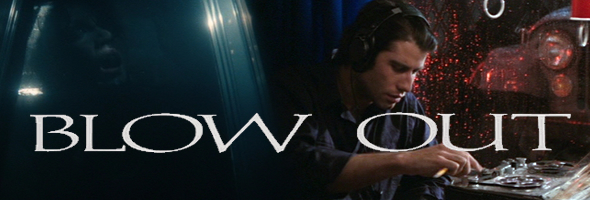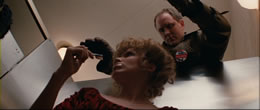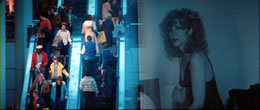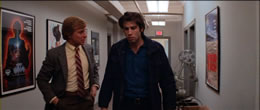
Color, 1981, 108m.
Directed by Brian De Palma
Starring John Travolta, Nancy Allen, John Lithgow, Dennis Franz
Criterion (Blu-Ray & DVD) (US RA/R1 HD/NTSC), MGM (US R1 NTSC) / WS (2.35:1) (16:9) / DD2.0
 A remarkable thriller completely buried by being released at the wrong time, Blow Out represents Brian De Palma at the peak of his filmmaking powers hot on the heels of his delirious Dressed to Kill and before his most enduring popular cult hit, Scarface. Hollywood was veering away from the darkness and cynicism often found in the "New Hollywood" films of the '70s, and with the arrival of Ronald Reagan, movie theaters were plunging into a permanent love affair with crowdpleasing, big budget blockbusters. Enter this twisted suspense film which melds elements like the Kennedy assassination, Chappaquiddick, Watergate, Blow-up, slasher films, trashy AIP posters, and a crash course in filmmaking basics into a concoction unlike any other. Seen now, its shocking, incredibly haunting finale now plays like a farewell love letter to the previous decade; a lot of people still have issues with the ending, of course, but it's certainly something you never forget.
A remarkable thriller completely buried by being released at the wrong time, Blow Out represents Brian De Palma at the peak of his filmmaking powers hot on the heels of his delirious Dressed to Kill and before his most enduring popular cult hit, Scarface. Hollywood was veering away from the darkness and cynicism often found in the "New Hollywood" films of the '70s, and with the arrival of Ronald Reagan, movie theaters were plunging into a permanent love affair with crowdpleasing, big budget blockbusters. Enter this twisted suspense film which melds elements like the Kennedy assassination, Chappaquiddick, Watergate, Blow-up, slasher films, trashy AIP posters, and a crash course in filmmaking basics into a concoction unlike any other. Seen now, its shocking, incredibly haunting finale now plays like a farewell love letter to the previous decade; a lot of people still have issues with the ending, of course, but it's certainly something you never forget.
While out recording new sound effects near a desolate Philadelphia bridge one night for a horror film called Coed Frenzy, soundman Jack Terry (Travolta) records the sound of a tire blowout that sends a car crashing into the water. He dives in to find a dead driver and a panicking woman, Sally (Allen), whom he rescues. At the hospital he learns that the deceased driver was a major politician and the likely next President of the United States. Various parties attempt to dissuade Jack from talking about Sally's presence, and when she gets skittish about his questions and tries to leave town, Jack begins to think that perhaps this was no accident at all. Using some published film frames shot by another witness (Franz) at the scene, he puts together an amateur film that proves the tire was shot out. Meanwhile an icepick-wielding assassin named Burke (Lithgow) is killing off prostitutes who resemble Sally and leaving Liberty Bell-shaped stab wounds on their bodies, a clue that the upcoming Centennial celebration might not be quite the cheerful event everyone has planned.
 Everyone on Blow Out gives 100% here, particularly the reuniting stars from De Palma's Carrie, Travolta and the vulnerable Allen, who was married to De Palma at the time and had appeared in several of his films. This would prove to be their last collaboration, closing a memorable period that saw other directors like John Carpenter making good use of their spouses as actors as well. Cinematographer Vilmos Zsigmond (who also shot De Palma's Obsession) delivers countless stunning scope compositions, while regular De Palma composer Pino Donaggio offers a beautiful score with one of his finest love themes (later used to brief but poignant effect in Death Proof). This film also proved to be wild curveball to critics who had been taking shots at the director as a Hitchcock imitator; here they wanted to call him an Antonioni copycat, but the final product is far too rich and personal to be the work of anyone else.
Everyone on Blow Out gives 100% here, particularly the reuniting stars from De Palma's Carrie, Travolta and the vulnerable Allen, who was married to De Palma at the time and had appeared in several of his films. This would prove to be their last collaboration, closing a memorable period that saw other directors like John Carpenter making good use of their spouses as actors as well. Cinematographer Vilmos Zsigmond (who also shot De Palma's Obsession) delivers countless stunning scope compositions, while regular De Palma composer Pino Donaggio offers a beautiful score with one of his finest love themes (later used to brief but poignant effect in Death Proof). This film also proved to be wild curveball to critics who had been taking shots at the director as a Hitchcock imitator; here they wanted to call him an Antonioni copycat, but the final product is far too rich and personal to be the work of anyone else.
One of those films you should absolutely never, ever watch pan and scanned on TV, Blow Out first appeared on DVD from MGM in a decent anamorphic transfer with only the trailer as an extra (and the truly awful poster art on the front, something that might also have to do with the film's unfairly obscure reputation). It's not too surprising that Criterion would make this their second De Palma title to hit DVD (after Sisters, and technically their third if you count their excellent laserdisc of Carrie). The themes of visual representation and the fluid roles of media make this a good companion piece to their special edition of Videodrome, and it's great as always to see De Palma participating in a special edition of one of his films. As usual he avoids doing a commentary, but he does sit down for a great one-hour video chat with director Noah Baumbach that covers the film's major themes, his hatred of coverage, Nancy Allen's claustrophobia, the casting process, and the battle to keep the film's ending.
 Allen (who still looks great) appears for a separate video interview in which she discusses her character's accent, her surprised initial reading with Travolta, and her feelings about the film's unwise release date, among many other topics. Both are terrific extras and highly recommended. This was also De Palma's first film to use a real Steadicam (in that great opening sequence), so the intentor of the system, Garrett Brown, talks about using it in the film, which came out shortly after Stanley Kubrick's pioneering use of it in The Shining. Other extras include Louis Goldman photos from the shoot, the theatrical trailer, and one very hefty extra, Brian De Palma's first film, Murder à la Mod. This wild little 1968 number lays out several of De Palma's visual motifs (especially some fun Hitchcock nods) and features regular player William Finley; it was previously issued from Something Weird as a double bill with The Moving Finger, and flashes of it can be seen on a TV screen in Blow Out, too. The transfer here is comparable to the excellent one seen previously on DVD, which was also taken from the original negative. As for the liner notes booklet, Michael Sragow offers some new observations called "American Scream" about the film's critical reception (especially with De Palma champion Pauline Kael) and some of its themes, while Kael's "Portrait of the Artist as a Young Gadgeteer" essay about De Palma is included as well. Most amusingly, you also get a two-page reproduction of Senator McRyan's car crash frame by frame and a great spread of the poster art seen in the film like Squirm and Without Warning. As for the feature itself, the transfer from the 35mm negative supervised by De Palma looks much more solid than the MGM disc (it's the first time that funky blue-and-red-and-white wallpaper in Allen's hotel room didn't bleed all over the screen), but bear in mind this is a scruffy, early '80s film often shot in low lighting. Grain is especially heavy in the opening nocturnal scenes, which is as it should be, and overall it's a pleasing upgrade in every respect with the original two-channel stereo track retained as well (with optional English subtitles). The DVD was delivered for review here so the Blu-Ray should deliver the expected uptick in resolution, but clicking on any of the frame grabs here will give you an idea of how it looks. Definitely a satisfying disc no matter which format you prefer.
Allen (who still looks great) appears for a separate video interview in which she discusses her character's accent, her surprised initial reading with Travolta, and her feelings about the film's unwise release date, among many other topics. Both are terrific extras and highly recommended. This was also De Palma's first film to use a real Steadicam (in that great opening sequence), so the intentor of the system, Garrett Brown, talks about using it in the film, which came out shortly after Stanley Kubrick's pioneering use of it in The Shining. Other extras include Louis Goldman photos from the shoot, the theatrical trailer, and one very hefty extra, Brian De Palma's first film, Murder à la Mod. This wild little 1968 number lays out several of De Palma's visual motifs (especially some fun Hitchcock nods) and features regular player William Finley; it was previously issued from Something Weird as a double bill with The Moving Finger, and flashes of it can be seen on a TV screen in Blow Out, too. The transfer here is comparable to the excellent one seen previously on DVD, which was also taken from the original negative. As for the liner notes booklet, Michael Sragow offers some new observations called "American Scream" about the film's critical reception (especially with De Palma champion Pauline Kael) and some of its themes, while Kael's "Portrait of the Artist as a Young Gadgeteer" essay about De Palma is included as well. Most amusingly, you also get a two-page reproduction of Senator McRyan's car crash frame by frame and a great spread of the poster art seen in the film like Squirm and Without Warning. As for the feature itself, the transfer from the 35mm negative supervised by De Palma looks much more solid than the MGM disc (it's the first time that funky blue-and-red-and-white wallpaper in Allen's hotel room didn't bleed all over the screen), but bear in mind this is a scruffy, early '80s film often shot in low lighting. Grain is especially heavy in the opening nocturnal scenes, which is as it should be, and overall it's a pleasing upgrade in every respect with the original two-channel stereo track retained as well (with optional English subtitles). The DVD was delivered for review here so the Blu-Ray should deliver the expected uptick in resolution, but clicking on any of the frame grabs here will give you an idea of how it looks. Definitely a satisfying disc no matter which format you prefer.